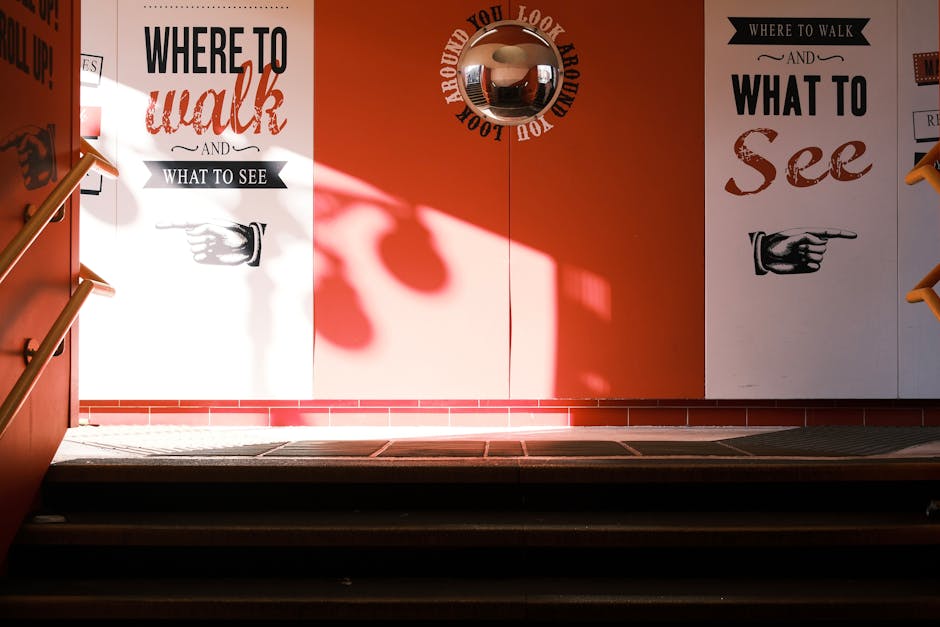Navigating the Modern Workplace: A Comprehensive Guide to Wayfinding Solutions
“This comprehensive guide explores the concept of wayfinding in modern workplaces, from fundamental principles to advanced digital solutions. Learn how strategic wayfinding systems can enhance employee experience, improve operational efficiency, and create more intuitive, accessible environments for everyone in your organization. ”

Understanding Wayfinding in the Modern Workplace
Wayfinding encompasses all the ways in which people orient themselves in physical space and navigate from place to place. In the context of workplace management, it's a critical element that influences how employees and visitors experience your environment. Effective wayfinding doesn't just help people find their way—it enhances productivity, reduces frustration, and contributes to a positive workplace culture.

The concept of wayfinding was first introduced by urban planner Kevin Lynch in his 1960s book, "The Image of the City." He described how people interpret and navigate through physical environments using mental maps. Today, this concept has evolved significantly, especially in workplace settings where complex layouts, hybrid work models, and flexible spaces demand intuitive navigation systems.
The Business Case for Strategic Wayfinding
Implementing effective wayfinding solutions offers numerous benefits for organizations of all sizes:
Improved Operational Efficiency
Poor wayfinding leads to wasted time and reduced productivity. When employees struggle to locate meeting rooms, collaborative spaces, or colleagues, it creates unnecessary friction in the workday. According to workplace efficiency studies, employees can waste up to 15 minutes per day simply trying to navigate their workplace—time that could be better spent on value-added activities.
Enhanced User Experience
A well-designed wayfinding system creates a more positive experience for everyone in your building. For employees, it reduces stress and frustration. For visitors, it creates a professional first impression and demonstrates your organization's commitment to accessibility and user-centered design.
Support for Flexible Work Models
As more organizations adopt activity-based workplace models and flexible seating arrangements, effective wayfinding becomes even more critical. When desk assignments change regularly or employees need to locate specific types of work areas, intuitive navigation systems help maintain productivity and satisfaction.
Elements of Effective Wayfinding Systems
Visual Cues and Environmental Graphics
Visual elements form the foundation of any wayfinding system. These include:
- Color coding for different departments or zones
- Consistent iconography that transcends language barriers
- Strategic use of typography for readability
- Environmental graphics that reinforce branding while providing directional information
The most effective systems use a combination of these elements to create intuitive navigation paths that feel natural to users.

Digital Wayfinding Solutions
Modern workplaces increasingly rely on digital tools to enhance wayfinding:
- Interactive kiosks in lobbies and key decision points provide searchable directories and turn-by-turn directions
- Mobile applications that offer personalized navigation, room booking capabilities, and colleague location features
- Digital signage that can be updated in real-time to reflect changes in space usage or temporary redirections
These digital signage solutions are particularly valuable in dynamic environments where space utilization changes frequently.
Architectural Elements
The physical design of your space plays a crucial role in wayfinding:
- Clear sightlines that allow users to see destinations from decision points
- Architectural features that serve as landmarks for orientation
- Thoughtful space planning that creates natural flow patterns
- Lighting design that highlights pathways and key areas
When architectural elements and wayfinding systems work together, navigation becomes intuitive rather than requiring conscious effort.
Designing User-Centered Wayfinding Systems
Understanding User Journeys
Effective wayfinding design begins with mapping the various journeys users take through your space. Consider:
- First-time visitors navigating from reception to meeting rooms
- New employees learning the layout during onboarding
- Regular employees moving between different work zones
- Delivery personnel accessing service areas
- Emergency evacuation routes for all occupants
Each journey has different requirements and pain points that your wayfinding system should address.
Accessibility Considerations
Inclusive wayfinding design ensures that everyone can navigate your space regardless of ability:
- Braille and tactile elements for visually impaired users
- Clear, high-contrast visuals for those with partial vision
- Multiple formats of information (visual, auditory, tactile)
- Consideration of viewing heights for wheelchair users
- Simple, clear language for those with cognitive disabilities
Following accessibility standards isn't just about compliance—it's about creating truly inclusive environments where everyone can navigate with dignity and independence.
Cultural and Linguistic Factors
In global organizations, wayfinding systems must account for cultural and linguistic diversity:
- Use of universal symbols and pictograms
- Multilingual signage where appropriate
- Consideration of cultural differences in spatial perception
- Avoidance of culturally specific references or metaphors
A thoughtfully designed system transcends language barriers and creates an inclusive experience for international employees and visitors.
Implementing Digital Wayfinding Technologies
Mobile Wayfinding Applications
Workplace mobile applications with wayfinding capabilities have become increasingly sophisticated, offering features such as:
- Indoor positioning using Bluetooth beacons or Wi-Fi triangulation
- Personalized directions based on user preferences
- Integration with calendar systems for meeting room navigation
- Colleague location features for improved collaboration
- Accessibility options for diverse user needs
These applications can transform how employees interact with their workplace, making navigation seamless and intuitive.

Interactive Kiosks and Digital Directories
Strategically placed interactive kiosks serve as wayfinding hubs throughout your facility:
- Touch-screen interfaces with intuitive search functions
- 3D maps with "you are here" indicators
- QR codes that transfer directions to mobile devices
- Real-time updates on space availability and occupancy
- Visitor check-in integration for streamlined experiences
Modern kiosks can also incorporate artificial intelligence to provide more natural interactions through voice commands or natural language processing.
Integration with Workplace Management Systems
The most effective wayfinding solutions integrate with broader workplace management systems:
- Room booking systems that guide users to their reserved spaces
- Desk hoteling platforms that help employees find available workstations
- Visitor management systems that create personalized wayfinding experiences
- Facility management tools that update navigation information when spaces are reconfigured
This integration creates a seamless experience while providing valuable data on space utilization and movement patterns.
Measuring Wayfinding Effectiveness
Key Performance Indicators
To evaluate your wayfinding system, consider tracking metrics such as:
- Time-to-destination for various user journeys
- Number of wayfinding-related questions to reception or help desks
- User satisfaction ratings for navigation experiences
- Reduction in missed or late meetings due to navigation issues
- Usage statistics for digital wayfinding tools
These metrics provide insights into how well your system is performing and where improvements might be needed.
User Feedback and Continuous Improvement
Regular feedback from users is essential for refining your wayfinding system:
- Conduct periodic surveys about navigation experiences
- Implement simple feedback mechanisms at key decision points
- Observe how people actually move through your space
- Test new wayfinding elements with diverse user groups before full implementation
- Create a process for regular updates based on changing needs
The most successful wayfinding systems evolve over time in response to user feedback and changing workplace requirements.
Future Trends in Workplace Wayfinding
Augmented Reality Wayfinding
Augmented reality (AR) is poised to transform workplace navigation by overlaying digital information on the physical environment:
- AR-enabled smartphones or smart glasses that display directional arrows in real-time
- Virtual assistants that guide users through complex buildings
- Contextual information about spaces and resources as users move through the environment
- Personalized experiences based on individual preferences and needs
As AR technology becomes more accessible, it will likely become a standard component of advanced wayfinding systems.
AI-Powered Predictive Navigation
Artificial intelligence can enhance wayfinding by predicting user needs and providing proactive assistance:
- Learning individual movement patterns to offer personalized suggestions
- Anticipating potential bottlenecks and suggesting alternative routes
- Optimizing meeting room assignments based on participant locations
- Adapting to changing conditions such as temporary closures or crowding
These intelligent systems create more responsive environments that adapt to how people actually use spaces.
Biometric Integration
Emerging wayfinding systems may incorporate biometric elements for a more seamless experience:
- Facial recognition that triggers personalized directions
- Voice identification for natural language wayfinding queries
- Gesture-based interactions with digital signage
- Personalized environmental adjustments that follow users through a building
While these technologies offer exciting possibilities, they must be implemented with careful attention to data privacy and security considerations.
Creating a Comprehensive Wayfinding Strategy
Assessing Your Current State
Before implementing new wayfinding solutions, thoroughly evaluate your existing situation:
- Conduct a wayfinding audit to identify current pain points and challenges
- Map typical user journeys through your space
- Gather feedback from employees, visitors, and facilities staff
- Analyze any available data on navigation issues or inefficiencies
- Review compliance with accessibility requirements
This assessment provides the foundation for a targeted improvement strategy.
Developing an Implementation Plan
A successful wayfinding project requires careful planning:
- Establish clear objectives and success metrics
- Determine budget and resource requirements
- Create a phased implementation approach
- Identify stakeholders and establish communication channels
- Develop a timeline with key milestones
Consider forming a cross-functional team that includes facilities management, IT, HR, and representatives from different departments to ensure diverse perspectives.
Change Management and User Adoption
Even the best wayfinding system will fail if users don't understand or embrace it:
- Communicate the benefits of new wayfinding tools and approaches
- Provide training and resources for employees and frequent visitors
- Gather feedback during initial implementation and make adjustments
- Celebrate successes and address concerns promptly
- Maintain ongoing awareness through regular communications
Effective change management is critical for realizing the full benefits of your wayfinding investments.
Conclusion: Creating Intuitive Navigation Experiences
In today's complex and dynamic workplace environments, strategic wayfinding is more important than ever. By combining thoughtful physical design with advanced digital tools, organizations can create intuitive navigation experiences that enhance productivity, support collaboration in the workplace, and contribute to overall workplace satisfaction.
Whether you're designing a new facility, renovating an existing space, or simply looking to improve the user experience in your current environment, investing in effective wayfinding solutions delivers significant returns in operational efficiency and employee experience.
By understanding the fundamental principles of wayfinding, leveraging appropriate technologies, and maintaining a user-centered approach, you can create navigation systems that feel intuitive and natural—allowing everyone in your workplace to focus on their work rather than finding their way.